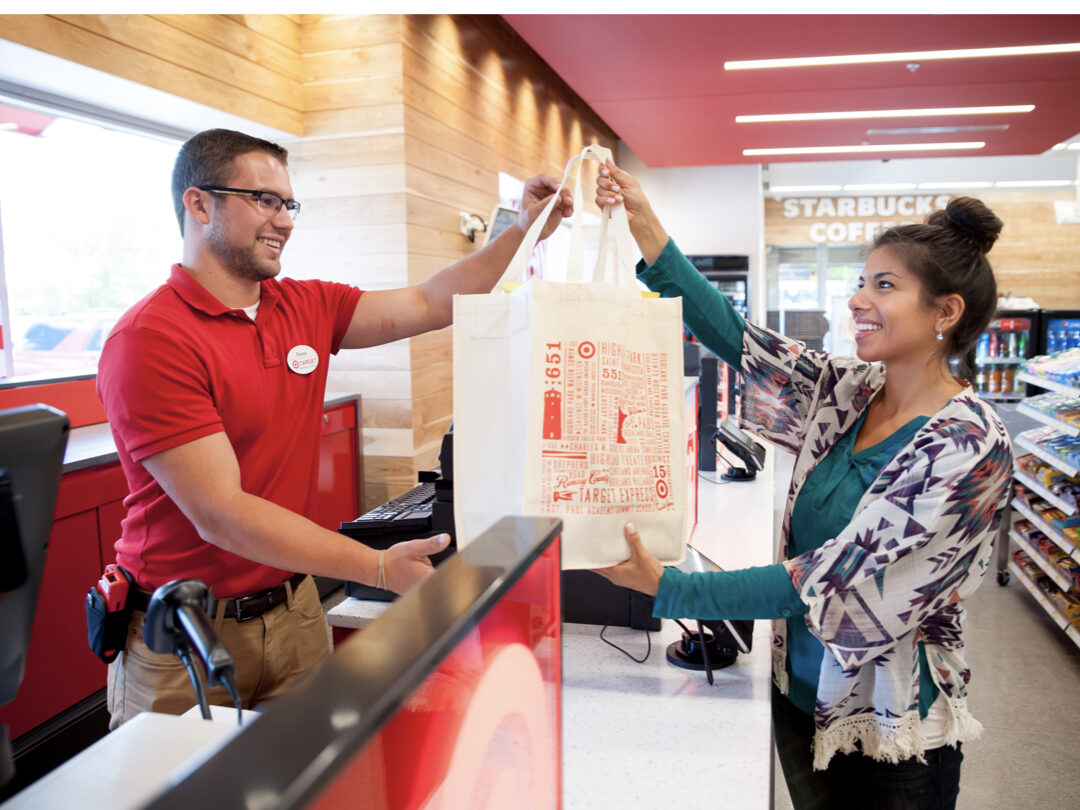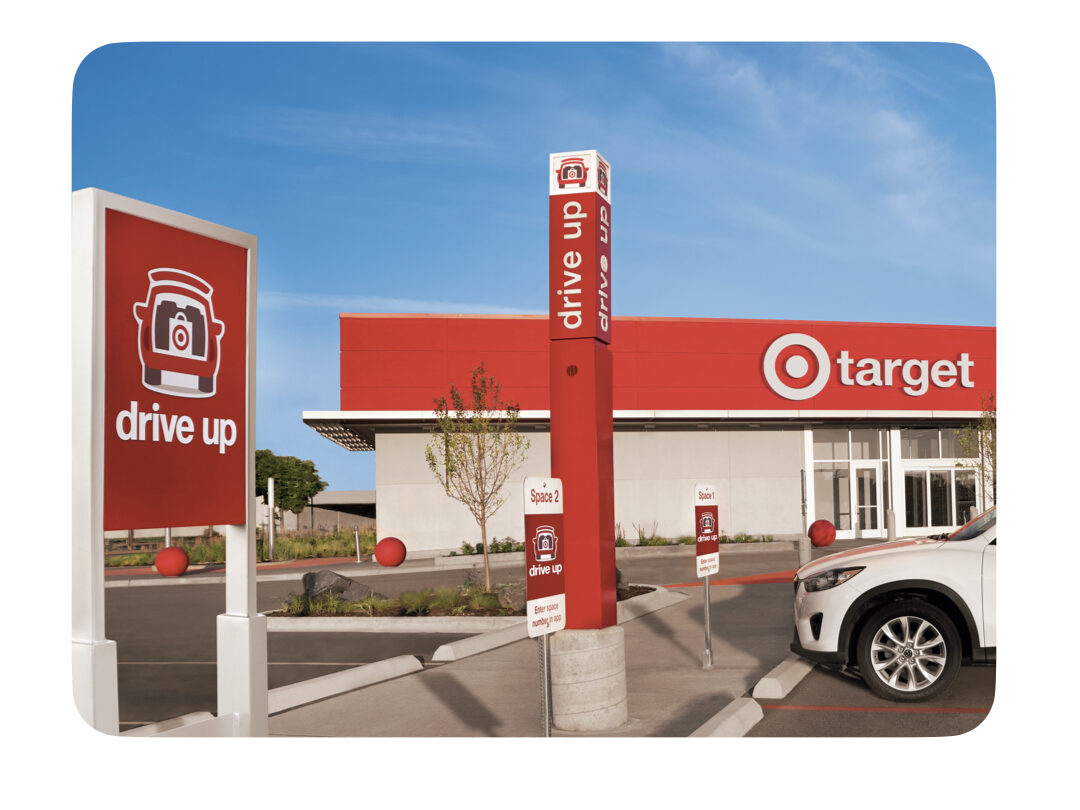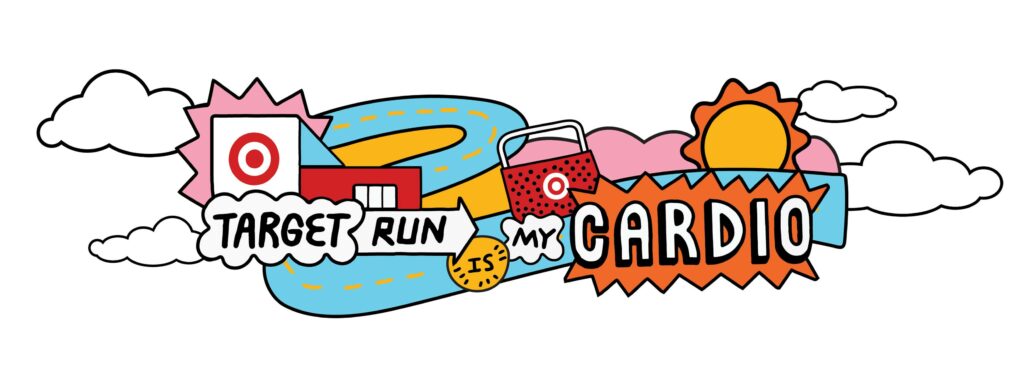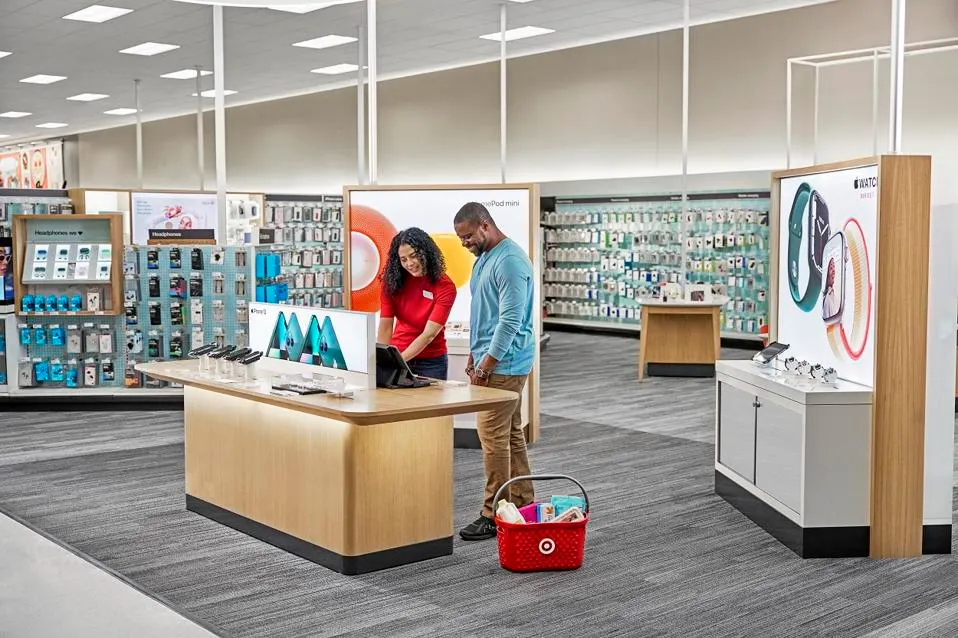Target Corporation is one of the retail companies in the USA that has established a strong brand image for offering high-quality products and services. Due to Target’s competitive advantage and strategy, it has been able to position itself as the 6th largest retailer in the USA as of 2023 with worldwide retail sales of $107.59 billion.
This American general merchandise retailer was founded in 1962 and is headquartered in Minneapolis, Minnesota U.S. Since its inception, the company has succeeded in marking its presence worldwide by offering its customers quality brands at affordable prices.
The company’s tagline “Payless, Expect More” gives Target a competitive advantage because it positions the brand as a low-cost store with high-quality product offerings. We will be looking at other competitive advantages of Target and the strategy it uses to stay ahead of its competitors.
Read about: Starbucks’ Competitive Advantage and Strategy
Target competitive strategy
To gain a competitive advantage over competitors, companies design a long-term strategy with the aim of getting ahead of the competition in the market. This can be achieved by using any of these four strategies- differentiation leadership strategy, cost leadership strategy, differentiation focus strategy, and cost focus strategy.
It’s no news that Target is competing against the online retail company, Amazon and brick-and-mortar stores like Kroger, Walmart, and Costco. As a result, Target has implemented various strategies to outdo these companies and to effectively position itself in its industry. It chooses to adopt a combination of cost leadership, and differentiation leadership strategy to stay ahead of the competition.
This combination has helped the company build a strong and loyal customer base. Through implementing these competitive strategies, Target offers low prices and differentiated products and services to its customers.
Target’s cost leadership strategy
Target uses a cost leadership strategy as its main generic strategy. This is a strategy wherein a company lowers its costs of production to offer quality products to customers at low prices. This is an effective strategy for Target, especially as a large company with lots of buying power.
This retail chain targets the middle class, which makes up the largest proportion of the overall consumer market mix in most countries. Generally, middle-class consumers place high importance on pricing factors and this is why the company uses a cost leadership strategy to meet the needs of this consumer segment. Hence, by using a cost leadership strategy, Target is able to position itself as an upscale discount chain.
Target offers trendy merchandise to customers at affordable prices and this strategy has helped Target’s competitive advantage because it allows the company to expand its market share. The company focuses on affordability and easy accessibility of its merchandise across the globe, which has led to high brand awareness and high sales growth.
Also, apart from charging low prices by lowering production costs, Target offers discounts and coupons in order to achieve sales targets and stay ahead of the competition. Such discount and promotional campaigns help to increase brand popularity and encourage consumption. As of 2023, Target is the fourth largest discount retailer in the world.
Target’s differentiation leadership strategy
Target’s competitive advantage is based on more than just pricing; it also encompasses quality, style, and trend. This is a differentiation strategy that has been consistently applied since the company was launched.
Target uses a differentiation strategy together with cost leadership for sustainable competitive advantage. The company adopts differentiation as a secondary generic strategy wherein it expands its customer base by providing unique features of its products.
Target Corporation is able to differentiate its brand by embedding innovation and addressing consumers’ changing interests. For instance, in September 2020, the company added hundreds of new food and beverage items that are exclusive to its stores and website and also launched Good & Gather Signature, a line of premium foods like gourmet pizzas, small-batch Italian sauces, and specialty coffees.
Through this competitive strategy, Target positions its product offerings to stand out and be different from its competitors. It offers a wide variety of products to match the unique needs of consumers. The diversified product lines it offers enable the company to achieve a strong competitive position in the market. It offers a true omnichannel experience, where customers can mix buying in-store and online.
The company also offers differentiated augmented services that increase consumer’s preference for Target Corporation over other brands. For instance, Target’s acquisition of Shipt, an online delivery company provided the company an opportunity to offer same-day delivery of goods to customers.
Target’s brand slogan “Payless, Expect More” is also used to set the differentiation basis. The company’s unique and distinctive slogan establishes a strong brand image in the minds of consumers.

See also: Nike’s Competitive Advantage and Strategy
What is Target’s competitive advantage?
Target’s competitive advantage is derived from the company’s business model which is based on promoting positive customer experience and a dedication to employees’ satisfaction. The company’s ability to form and maintain a loyal customer base is its main competitive advantage. Other target’s competitive advantages include extensive nationwide presence, multipurpose centers that fulfill consumer needs physically and digitally, competitive pricing, strong brand image, a broad selection of exclusive brands, etc.
Check out: Tesla’s Competitive Advantage and Strategy
Target’s competitive advantages
- Extensive product line
- Extensive nationwide presence
- Strong brand image
- Strong strategic partnerships
- Large and loyal customer base
- Efficient logistics and supply management
- Strong marketing campaigns
- Small stores in busy locations
- Competitive Pricing
- A broad selection of Private Label and Exclusive Brands
- Employee satisfaction
- Enticing retail concessions
Target’s competitive advantages include every parameter that allows the company to raise more sales and superior margins than its competitors. These could be any strength or edge that the company has over its competitors. We will be discussing some of these parameters and how they make Target so successful and unique.
Extensive product line
One of Target’s competitive advantages is its extensive product line. The company has a large and diverse product line, selling a wide variety of food and general merchandise. Target is notable for its focus on upscale, trend-forward merchandise that ranges across clothing, groceries, household goods, electronics, toys, and much more.
Also, one of the things that makes Target Corporation unique is its customization of the assortment of its merchandise in each store to meet the needs of its neighborhood and local customers.
Extensive nationwide presence

Another Target’s competitive advantage is its extensive nationwide presence. This retail chain as of 2023, operates an extensive network of about 1,948 stores throughout the United States. As a result of its nationwide presence, roughly 75% of Americans live within 10 miles of a Target store. This gives Target a competitive advantage over a retail chain like Amazon which solely relies on eCommerce.
Even in e-commerce, Target is still very much competitive. The company has dedicated much time and effort to optimize its own e-commerce platforms, which are assisted by about 44 distribution centers operating across the nation. These distribution centers fulfill the needs of digital shoppers and also support stores by maintaining a healthy inventory.
Target created mobile apps for its customers to facilitate online shopping and has also managed to create an extensive nationwide presence through its efficient network of stores and distribution centers. This has positively impacted customer reach and, in return, increased the company’s yearly profits. For instance, due to a 2.7% increase in online traffic, Target’s comparable sales and operating income grew in 2019 by 3.4% and 13.3% respectively.
Strong brand image
A prominent Target competitive advantage is its strong brand image. This retail chain is known for quality products at an affordable price. As a matter of fact, the brand’s tagline “Payless, Expect More” gives Target a competitive advantage because it positions the brand as a low-cost store with high-quality product offerings.
This has worked well in creating a consumer base that is loyal to the brand and regularly ready to purchase items from Target’s stores. In order to maintain its customer base, the company has been consistent across all platforms, in its advertisements, store inventory, and packaging of goods sold within its stores.
Large, loyal customer base
Target has a large loyal customer base which gives it a competitive advantage over its competitors. The company combines affordability and quality which has won the hearts of American shoppers. It offers discounts and coupons which help to encourage consumption and increase the customer base.
Over the years, Target has been committed to providing an enjoyable shopping experience for every customer. A lot of people who shop at Target generally like the aura and set-up of the store. Due to the store’s overall aesthetic and operations, many people frequent the stores, thus, creating a large customer base for the brand.
A large, loyal customer base means more profits for Target, an increase in ROI, and effective word-of-mouth marketing from customers. All these enhance Target’s competitive advantage in its industry.
Efficient logistics and supply management
Target has a competitive advantage as a result of its superior supply management system that runs effectively and efficiently. It manages its inventory levels effectively and due to this, its inventory turnover ratio has continued to improve over the years together with its cash conversion cycle. This is one of the factors that makes Target so successful.
Strong marketing campaigns and strategies

Operating a solid marketing campaign is an important source of Target’s competitive advantage over other retail brands. Its marketing strategies are completely customer-focused and it regularly evaluates the customer-driven data from its sales in order to determine its marketing strategies.
In 2019, for instance, Target spent an estimated amount of $1.65 billion in advertising, using both physical and digital promotional methods. This retail chain is exceptionally skilled at using new marketing strategies and using major social media platforms like Twitter, Instagram, Facebook, etc. It uses social media resources to link customers straight to the goods they are looking for and to post announcements on new arrivals and limited collaborative collections.
The company has more than 22,760,711 followers on its Facebook page and about 5.4 million followers on its Instagram page as of 30 August 2023. This gives Target a larger digital reach and engagement than some of its competitors.
As part of its marketing approach, Target also uses strong marketing campaigns to gain a competitive advantage. A typical example of a marketing campaign that enhanced Target’s competitive advantage is the Target Run campaign.
This is one of the most effective campaigns that the company has ever done. Since its launch in 2014, Target Run has produced a phenomenal return on investment. Today this campaign is playing a big role in driving awareness of Target’s same-day fulfillment options which include in-store pick-up, drive-up, and same-day delivery with Shipt.
Also, Target Weekly is one of Target’s major social media marketing campaigns that helped attract a huge number of customers through weekly promotional offers.
Small stores in busy locations
One of Target’s competitive advantages is its strategic placement of small-scale stores in busy locations. Spotting a niche in the discount store market, this retail chain has significantly established its stores in densely populated areas such as college regions, commercial districts, and city blocks. That is, Target stores can be seen in major cities like New York and Los Angeles within relatively small proximities to one another.
Due to the strategic positioning of Target’s stores, it attracts a more urbanized clientele that consists of students, affluent millennials, and city workers who enter the stores willing to pay higher sums. The company stocks these small formatted stores with merchandise that meets the community’s demand, e.g. stocking stores in university areas with school supplies.
The placement of these small stores in busy locations also gives Target a competitive advantage over retail brands like Costco and Walmart which generally operate warehouse layouts or 180,000 square supercenters in more rural regions.
Competitive Pricing
Since Target’s inception, it has intended to differentiate its stores from other retail brands by offering more upscale, trend-forward merchandise at lower costs, instead of the traditional concept of focusing on low-priced goods.
When comparing the prices of general merchandise between Amazon, Target, and Walmart, one may hardly see a difference. However, Target is known to spike the prices of merchandise in wealthier areas, especially when a customer is shopping online. This pricing strategy gives Target a competitive advantage.
Target’s competitive pricing strategy also includes offering discount prices, though charging a couple of dollars more than Walmart. This competitive pricing advantage has made Target slightly more profitable than Walmart in the long run. This is because Walmart aims to offer the lowest price possible for its goods, while Target, on the other hand, focuses more on profit margin.
For the past five years as seen in the table below, Target has generated better gross profit margins compared to Walmart.
| Years | Target Corporation’s Gross Profit Margin | Walmart’s Gross Profit Margin |
|---|---|---|
| 2018 | 28.4% | 24.7% |
| 2019 | 28.9% | 24.5% |
| 2020 | 28.4% | 24.1% |
| 2021 | 28.3% | 24.3% |
| 2022 | 23.6% | 24.4% |
| Data was sourced from www.statista.com | Data was sourced from www.statista.com |
When comparing these two retail brands from a financial perspective, it is evident that Target is slightly more profitable than Walmart. Walmart has a lower gross profit margin and net profit margin because of its everyday low-price strategy which features a low-price guarantee policy. Target, on the other hand, minimizes its overhead and for its pricing uses economies of scale, value, and discount pricing tactics.
Also, instead of selling a vast assortment of products like Walmart or Amazon, Target also chooses to offer a limited range of private and company-owned labels in order to generate higher revenues and manage prices.
A broad selection of Private Label and Exclusive Brands
Having a broad selection of private label and exclusive brands is one of Target’s competitive advantages. When customers shop at Target, they have access to different unique brands that are either privately owned or exclusive to the company.
When comparing stock levels, the supply chain of Costco and Walmart offers a significantly higher breadth of merchandise compared to Target. Nevertheless, Target puts more effort into specific departments, in order to offer higher-quality goods. It offers apparel, home decor, household essentials, groceries, electronics, appliances, and baby products under a Target-owned brand.
Target also partners with designers and known brands to launch products that are exclusively found at Target. This raises Target’s profile and also makes brands that customers already love available to them. About one-third of the total sales of this retail chain come from its owned and exclusive brands.
Target’s owned and exclusive brands include:
- A New Day– Clothing line for women
- All in Motion– Activewear
- Boots & Barkley– Pet food and supply line
- Sutton & Dodge– Premium meat line
- Good & Gather– Food and beverage brand
- Threshold– Premium furniture line
- More Than Magic– Tween-focused lifestyle brand for girls
- Wondershop– Christmas decoration brand
- Xhilaration– Line of sleepwear and swimwear
- Pillowfort– Children’s line of bedding
- Cat & Jack– Children’s line of apparel and accessories
- Merona– Clothing brand
- Ava & Viv– Clothing line for women
- Brightroom– Line of storage solutions
- Stars Above– In-house brand for sleepwear
Employee satisfaction
Employee satisfaction is key to business success because an employee-friendly organization positively influences the overall customer experience. Lack of worker continuity is one of the major issues that retail brands face and Target has managed to tackle this issue to a great extent.
A key competitive advantage of Target is its human resource management which elevates company performance and maximizes employee satisfaction. Having employees come in and leave the company frequently eats up valuable time and resources.
Therefore, in order to retain employees and maximize employee satisfaction, Target implements a long list of employee benefits such as Target Flex, private medical insurance, subsidized gym memberships, sick pay, childcare vouchers, and employee discounts. The company focuses on staffing, organizational culture, employee retention, and employee development. This, in turn, contributes to Target’s competitive advantage over other retail brands.
Strong strategic partnerships and retail concessions

One of Target’s competitive advantages is its strong strategic partnerships and retail concessions. Target seeks partners and actively collaborates with brands to enhance customers’ shopping experience in a way that customers are able to make a lot of purchases on a single trip to Target stores, which grows their love for the brand.
Target implemented a shop-in-shop concept where the company partners with strong brands like Apple, Starbucks, Disney, and Ulta Beauty. This shop-in-shop concept is a partnership wherein these brands have a dedicated space within a Target store. Such branded concessions enhance Target’s competitive advantage over competitors because by leveraging these strategic partnerships, this retail chain is able to offer a wide variety of consumer goods that meet the needs of its customers.
Such partnerships enhance Target’s brand equity and attract a lot of customers. For instance, through Target’s strategic partnership with Apple, a shop-in-shop space was established with special lighting fixtures and customized Apple product displays.
Through this retail concession, customers are offered a shopping experience that is serviced by Target tech consultants who are trained by Apple. This collaboration also includes perks for customers such as a four-month free trial of Apple Fitness+ and expanded Apple services for Target Circle loyalty members.
See also: McDonald’s Competitive Advantage
Who are Target’s competitors?
Target’s biggest competitors include retail brands like Walmart, Costco, and Amazon. Target manages to compete with these brands by operating as a discount retail store that offers competitively priced and differentiated products and services to customers.
Walmart offers low-priced goods to customers compared to Target; while Costco’s customers are more affluent compared to Target and even Walmart’s customers. Amazon, on the other hand, has millions of customers through its e-commerce portal and also poses a strong competition to Target.
Other Target’s main competitors
- Macy’s
- Kroger
- GameStop
- Dollar General
- TJX
- Dollar Tree
- Kmart
- Home Depot
- Best Buy
Check out: Vertical Integration Examples of Companies
Target corporation core competencies
- Strong financial performance
- Innovative store format and clean stores
- Effective distribution and strategic partnership with delivery companies like Shipt
- An effective and vertically integrated supply chain
- Strong product portfolio and wide merchandise
- Affordable pricing
- Effective inventory management
- Solid marketing strategies
- Private label brands
- Effective financial services through the use of Target REDcard, Target Card, etc.
- Physical stores
- Logistic capabilities
- Efficient human resource management
- IT capabilities
- Presence of more than 1900 stores
- Effective distribution network
- Comprehensive customer loyalty programs
- Same-day delivery of goods to customers
- Higher focus on customer experience
- More than 409,000 employees
- Online distribution channels and Mobile app
Listed above are some of Target Corporation’s core competencies that help it gain a competitive advantage in the retail industry.
Last Updated on November 2, 2023 by Nansel Nanzip BongdapObotu has 2+years of professional experience in the business and finance sector. Her expertise lies in marketing, economics, finance, biology, and literature. She enjoys writing in these fields to educate and share her wealth of knowledge and experience.
